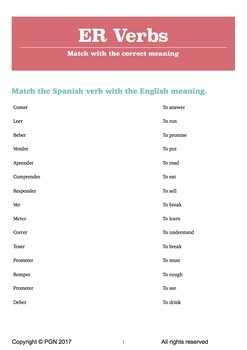
¿Qué idiomas habla usted? -Yo hablo español e inglés.Ħ. En mi casa comemos a las dos de la tarde.Ĥ.
Er ending verbs in spanish how to#
(Spanish students always forget how to conjugate verbs).Ģ. Los estudiantes de español siempre (olvidar) _ cómo conjugar los verbos. (This association helps those in need).ġ5. Esta asociación (ayudar)_ a los necesitados. ¿(Necesitar) _ algo? (Do you need something?).ġ4. (In front of the bus terminal, they sell handicrafts).ġ2. Enfrente de la terminal de autobuses (vender) _ artesanías. (My cousins travel very often to Mexico).ġ1. Mis primos (viajar) _ muy seguido a México. (My husband and I spend the weekends in the countryside).ġ0. Mi esposo y yo (pasar) _ los fines de semana en el campo. Ana (llevar) _ puesto un sombrero blanco. ¿Qué carrera (estudiar) _ en la universidad? (What major do you study at the university?).ħ. ❺ qué hora (abrir) _ el museo? (What time does the museum open?).Ħ. (-What languages do you speak? -I speak Spanish and English).ĥ. ¿Qué idiomas (hablar) _ usted? -Yo_ español e inglés. Yo (trabajar) _ para una empresa española. (In my house, we eat at two in the afternoon).ģ.

En mi casa (comer) _ a las dos de la tarde. Regular verbs are easy! You just need to put the conjugations into practice, and eventually using them will become a second nature.Ĭomplete each phrase with the correct conjugation of the verb in parentheses.ġ.

Therefore, depending on the ending of the verb (-ar, -er, -ir) we will always follow the same pattern when conjugating regular verbs, meaning that they are always consistent. For example, to conjugate the verb “trabajar”, we only need to change the ending -ar for another one that corresponds to the tense and subject of the phrase. To conjugate a regular verb, we need to change the ending of the infinitive form according to the tense and the subject. When it comes to conjugate a verb, that’s when we can classify them as regular or irregular. In Spanish, the infinitive form of a verb (regular or irregular) always ends in either -ar, -er or -ir (except for the reflexive verbs, which end in -se). Let’s do it! What makes a Verb “Regular”? We have also included a practice exercise at the end to see how much you grasped from this article. And so, In this article we will first get into understanding the pattern they follow to be able to conjugate them in the blink of an eye, and then we will list all the 50 most common regular verbs with their English translation. We call “regular verbs” the kind of verbs that always follow the same pattern when you conjugate them.


 0 kommentar(er)
0 kommentar(er)
